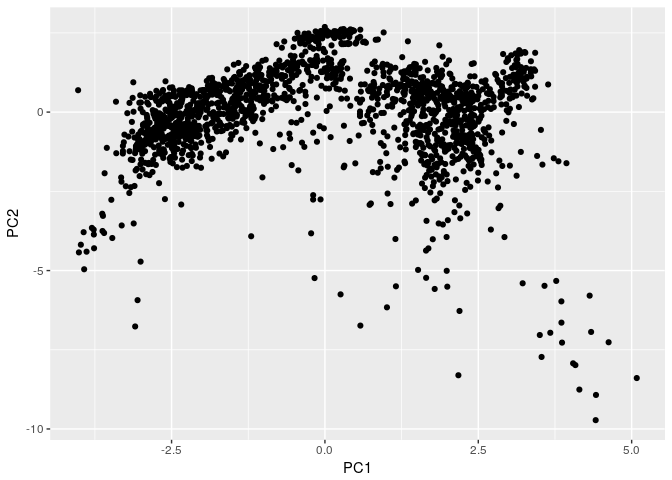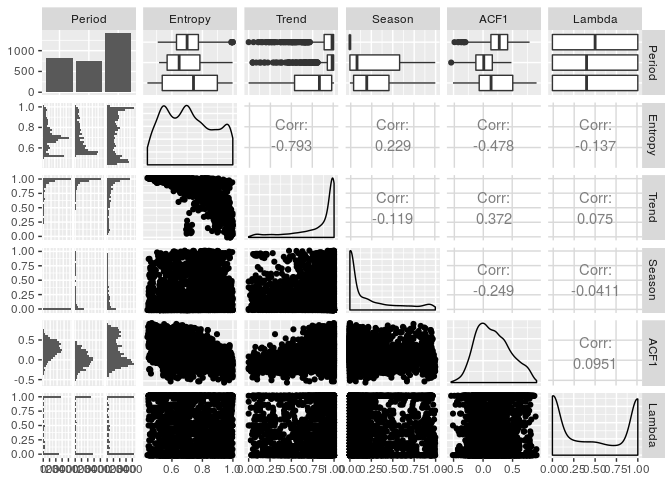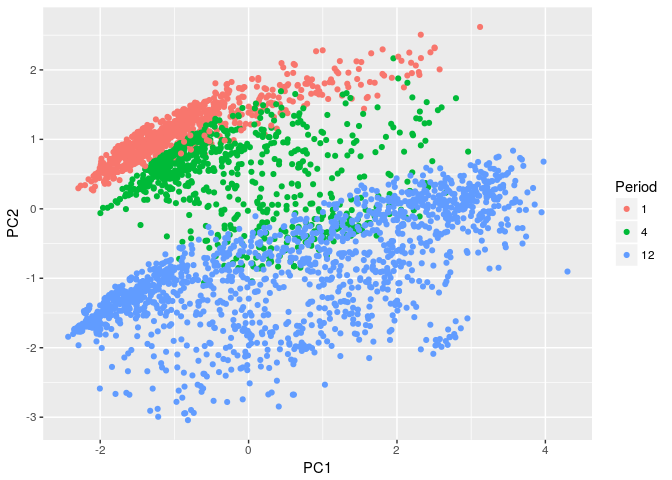The R package tsfeatures provides methods for extracting various features from time series data.
The stable version on R CRAN is coming soon.
You can install the development version from Github with:
# install.packages("devtools")
devtools::install_github("robjhyndman/tsfeatures")library(tsfeatures)
library(tidyverse)
library(anomalous)
# Compute the features used in Hyndman, Wang & Laptev (ICDM 2015).
# Note that crossing_points, peak and trough are defined differently
# in the tsfeatures package than in the Hyndman et al (2015) paper.
# Other features are the same. Using the real data from the paper
yahoo <- cbind(dat0, dat1, dat2, dat3)
hwl <- bind_cols(
tsfeatures(yahoo,
c("acf_features","entropy","lumpiness",
"flat_spots","crossing_points")),
tsfeatures(yahoo,"stl_features", s.window='periodic', robust=TRUE),
tsfeatures(yahoo, "max_kl_shift", width=48),
tsfeatures(yahoo,
c("mean","var"), scale=FALSE, na.rm=TRUE),
tsfeatures(yahoo,
c("max_level_shift","max_var_shift"), trim=TRUE)) %>%
select(mean, var, x_acf1, trend, linearity, curvature,
seasonal_strength, peak, trough,
entropy, lumpiness, spike, max_level_shift, max_var_shift, flat_spots,
crossing_points, max_kl_shift, time_kl_shift)# 2-d Feature space
prcomp(na.omit(hwl), scale=TRUE)$x %>%
as_tibble() %>%
ggplot(aes(x=PC1, y=PC2)) +
geom_point()library(tsfeatures)
library(tidyverse)
library(forecast)
# Compute the features used in Kang, Hyndman & Smith-Miles (IJF 2017).
# Note that the trend and ACF1 are computed differently for non-seasonal
# data in the tsfeatures package than in the Kang et al (2017).
# tsfeatures uses mstl() which uses supsmu() for the trend calculation with
# non-seasonal data, whereas Kang et al used a penalized regression spline
# computed using mgcv instead. Other features are the same.
M3data <- purrr::map(Mcomp::M3,
function(x){
tspx <- tsp(x$x)
ts(c(x$x,x$xx), start=tspx[1], frequency=tspx[3])
})
khs_stl <- function(x,...)
{
lambda <- BoxCox.lambda(x, lower=0, upper=1, method='loglik')
y <- BoxCox(x, lambda)
c(stl_features(y,s.window='periodic', robust=TRUE, ...), lambda=lambda)
}
khs <- bind_cols(
tsfeatures(M3data, c("frequency", "entropy")),
tsfeatures(M3data, "khs_stl", scale=FALSE)) %>%
select(frequency, entropy, trend, seasonal_strength, e_acf1, lambda) %>%
replace_na(list(seasonal_strength=0)) %>%
rename(
Frequency = frequency,
Entropy = entropy,
Trend = trend,
Season = seasonal_strength,
ACF1 = e_acf1,
Lambda = lambda) %>%
mutate(Period = as.factor(Frequency))# Fig 1 of paper
khs %>%
select(Period, Entropy, Trend, Season, ACF1, Lambda) %>%
GGally::ggpairs()# 2-d Feature space (Top of Fig 2)
prcomp(select(khs, -Period), scale=TRUE)$x %>%
as_tibble() %>%
bind_cols(Period=khs$Period) %>%
ggplot(aes(x=PC1, y=PC2)) +
geom_point(aes(col=Period))This package is free and open source software, licensed under GPL-3.


